
Wakefield is a village in the town of South Kingstown, Rhode Island, and the commercial center of the town. Together with the village of Peace Dale, it is treated by the U.S. Census as a component of the census-designated place identified as Wakefield-Peacedale, Rhode Island. West Kingston, another South Kingstown village, was the traditional county seat of Washington County. Since 1991, the Washington County Courthouse has been in Wakefield. The Sheriff's Office which handles corrections is also in Wakefield.

The Slater Mill is a historic textile mill complex on the banks of the Blackstone River in Pawtucket, Rhode Island, modeled after cotton spinning mills first established in England. It is the first water-powered cotton spinning mill in North America to utilize the Arkwright system of cotton spinning as developed by Richard Arkwright.

The Greystone Mill Historic District encompasses an early 20th-century textile mill complex on Greystone Avenue in Johnston and North Providence, Rhode Island. The complex consists of three brick buildings on the North Providence side of the Woonasquatucket River, a dam spanning the river, and a water tank near the dam in Johnston. The main structure consists of a series of structures combined to form a rambling structure, built between 1904 and 1911 to designs by Frank Sheldon and Son, an architectural firm that was a leading designer of textile facilities at the time.

The South Central Falls Historic District is a historic district in Central Falls, Rhode Island. It is a predominantly residential area, densely populated, which was developed most heavily in the late 19th century. It is bounded roughly by Broad Street to the east, the Pawtucket city line to the south, Dexter Street to the west, and Rand Street and Jenks Park to the north. It has 377 contributing buildings, most of which were built before 1920. The district was added to the National Register of Historic Places in 1991.

The Oriental Mills are a historic textile mill complex at 10 Admiral Street in Providence, Rhode Island. The site consists of seven buildings, constructed between about 1860 and 1917, by a variety of textile manufacturers that operated on the site. The oldest building, from c. 1860, was built by the Oriental Mills Manufacturing Company soon after its founding. It is a large three-story brick structure, presenting eight bays to Admiral Street and thirty to Whipple Street. It has a well-defined Italianate roof line with brackets. Building 3, which lies southeast of Building 1 and fronts on Oriental Street, is from the same time period and exhibits similar styling. Originally used for the manufacture of cotton textiles, the complex was purchased in 1918 by the American Silk Spinning Company, which pioneered the blending of nylon fibers into its products here.

The Hope Village Historic District is a historic rural mill settlement within Hope Village in Scituate, Rhode Island. Hope Village is located on a bend in the North Pawtuxet River in the southeastern corner of Scituate. Industrial activity has occurred in Hope Village since the mid-eighteenth century. Surviving industrial and residential buildings in the Historic District date back to the early 19th century. The village center sits at junction of Main Street and North Road (Rhode Island Route 116. Hope Village radiates out from the center with houses on several smaller side streets in a compact configuration. Currently there is little commercial or industrial activity in Hope Village and none in the Historic District. The present stone mill building on the south side of Hope Village was built in 1844 by Brown & Ives of Providence, expanded in 1871 and modified in 1910. Approximately one quarter of the village's current housing stock was built as mill worker housing by various owners of Hope Mill.
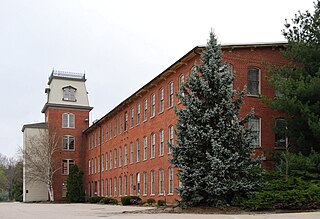
Lafayette Village is a historic district extending along Ten Rod Road in North Kingstown, Rhode Island. It encompasses a linear rural and industrial village, running from the Wickford Junction railroad crossing in the west to Angel Avenue in the east, and includes a number of residential properties on adjacent side streets. The centerpiece of the district is the Rodman Manufacturing Company complex, which operated here for a century beginning in the 1840s. The Robert Rodman Mansion, a Second Empire house with an elaborate porch, stands at 731 Ten Rod Road, and the Walter Rodman House, built in the 1870s, is even more elaborately decorated. Most of the residential stock in the district is mill-related housing built by the Rodmans for their workers.
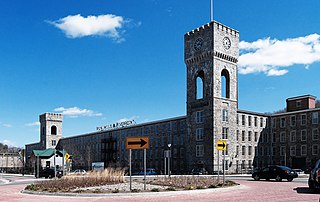
The Royal Mill Complex is an historic textile mill site at 125 Providence Street in West Warwick, Rhode Island. The mill complex was listed on the National Register of Historic Places in 2004. It has recently been completely renovated and remodeled into 250 residential apartments. The complex also includes the Ace Dye Works mill on the south side of the river, which has been converted into lofts. A pedestrian skybridge connects the two mills.

The Conant Thread—Coats & Clark Mill Complex District is a historic district encompassing a large industrial complex which straddles the border between Pawtucket and Central Falls, Rhode Island. This 50-acre (20 ha) industrial area was developed in two phases, with a number of buildings surviving from both of these periods. The first, between 1870 and 1882, resulted in the construction of Mills 2 through 5, a series of large three- and four-story brick buildings which were used in textile manufacturing. A brick office and stables from this period were demolished in 1977, and are the only known brick structures to have been lost. The second phase of construction was between 1917 and 1923, and included the construction of two additional four-story brick mills, a stuccoed recreation hall that has since been converted into a senior center, two two-story brick buildings, and a power plant. This works was first developed by J & P Coats, and became an internationally known source for cotton thread. It was for many years Pawtucket's largest employer.
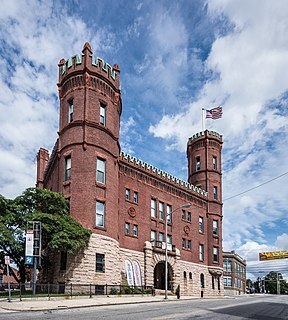
The Exchange Street Historic District is an industrial and civic historic district roughly along Exchange, Front and Fountain Streets in Pawtucket, Rhode Island. The 10.5-acre (4.2 ha) area is located just north of Pawtucket's downtown, and includes seven buildings and the Exchange Street Bridge, which spans the Blackstone River. The seven buildings are sandwiched between the river to the west, Broadway to the east, Blackstone Avenue to the north, and Front and Exchange Streets on the south. The most prominent buildings in the district are the 1926 William E. Tolman High School, sited high above the river just north of Exchange Street, and the Pawtucket Armory, built in 1895 and featuring crenellated towers. South of Exchange Street stand several mill buildings dating as far back as 1874.
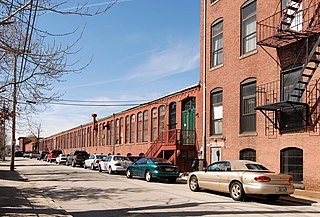
The Hope Webbing Company Mill is a historic textile mill at 999-1005 Main Street in Pawtucket, Rhode Island. The three brick buildings on this 7-acre (2.8 ha) are the surviving elements of what was once a larger complex, extending across Esten Avenue. The oldest portion of the main mill and the boiler house were built in 1889, with the mill growing by numerous additions through 1914. The preparing building was built in 1902 and enlarged in 1913. The Hope Webbing Company was established in 1883, and used these premises to manufacture narrow fabrics using many different types of fibers, including cotton, jute, wool, and silk. The company occupied all or part of the premises until 1994, when it moved its remaining production to Cumberland.
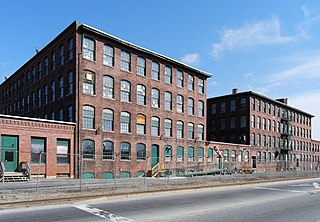
The Phillips Insulated Wire Company Complex is an historic industrial site at 413 Central Avenue in Pawtucket, Rhode Island. Encompassing three city blocks, the Phillips complex includes fourteen brick buildings with more than 350,000 square feet (33,000 m2) of space. They were built by the Phillips Insulated Wire Company between about 1898 and 1927. The company, established in 1888, was one of the most successful manufacturers of coated wire products, in an industry that ranked as the third-largest in Pawtucket. The complex was used by a variety of owners for the manufacture of such products until 2003.
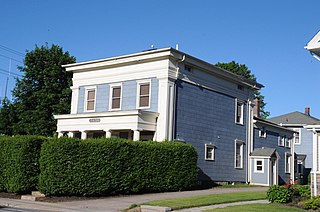
The North End Historic District is a predominantly residential historic district in northwestern Westerly, Rhode Island. The area traces the industrial development of Westerly, with proximity to both its central business district as well as water-based textile mills, and stone quarries further inland. Most of the district's architecture was built between 1832 and 1955. The district is bounded on the east by High Street; on the south by properties on Friendship, West, Pleasant Streets, Marriott Avenue and Industrial Drive; on the west by properties on Pleasant, Canal, Pierce and Pond Streets; and on the north by properties on Pond, Pierce, Pearl, and High Streets, and Turano Avenue.

The Blackstone Manufacturing Company Historic District encompasses the "New City" or "High Rocks" area of Blackstone, Massachusetts, an industrial village associated with the Blackstone Manufacturing Company, which began operations in 1809. It includes an area roughly surrounding Butler, Canal, Church, County, Ives, Main, Mendon, Old Mendon, and School Streets. The district includes a wide variety of worker housing, as well as a granite storehouse, the only surviving company structure. The district was added to the National Register of Historic Places in 1995.

The Jules Desurmont Worsted Company Mill is a historic mill at 84 Fairmount Street in Woonsocket, Rhode Island. The mill complex consists of three brick buildings, erected 1907-10 by Jules Desurmont, the owner of a textile firm in Tourcoing, a city in northern France, who had been drawn to Woonsocket by the promotional activities of Aram Pothier. The mill produced French worsted wool yarn until 1952, and was used for many years thereafter by smaller textile and industrial concerns.
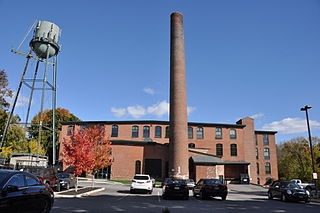
The Pocasset Worsted Company Mill is an historic industrial complex at 75 Pocasset Street in Johnston, Rhode Island. It consists of a complex of four connected brick buildings, built between 1897 and 1902. The buildings form a rough U shape on a 3.38 acres (1.37 ha) parcel of land between Pocasset Street and the Pocasset River. The two legs of the U are nearly identical main mill buildings, constructed in 1897 and 1902; they are joined by an engine and boiler house. The mill office building is attached to the southern (1897) mill building. The Pocasset Worsted Company was Johnston's largest employer in the early 20th century; its buildings were used for textile production until 1989.
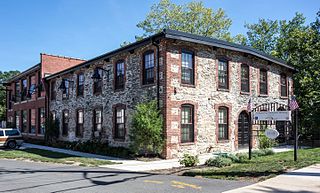
The Heaton and Cowing Mill is a historic industrial facility at 1115 Douglas Avenue in Providence, Rhode Island. The small mill complex consists of three connected building sections; the oldest is a c. 1832 rubble-walled two story mill building constructed by David Heaton and Martin Cowing on the banks of the West River. The partners used the facility to manufacture and dye cotton cloth. The building is the remnant of a much larger Geneva Worsted Company works that Heaton and Cowing built on the site in the 1860s and 1870s. The building was used, with a major brick addition c. 1930, for textile production until the 1950s, until its last textile owner, the Wanskuck Mill, shut down. It served a variety of light industrial businesses, and in 1982 a concrete block building was added to its rear. Most of its original waterworks infrastructure has either been filled in, or was destroyed by flooding in 2010.

The Standard Paper Box Corporation is a historic industrial complex at 110 Kenyon Street in Pawtucket, Rhode Island. The complex consists of four buildings built between 1914 and 1971, primarily for the purpose of manufacturing boxes for the jewelry industry that was a major economic force in Pawtucket and adjacent Attleboro, Massachusetts. The buildings are notable in the historical development of power systems for industrial facilities, retaining in situ elements of several generations of electro-mechanical power infrastructure. The main building, now a two-story brick structure was built in 1914 by the Standard Paper Box Corporation, which operated on the premises until 1933, enlarging it with a second building in the 1920s. The complex was purchased by Donald Young, Inc., which expanded the premises again, raising the main building from one to two stories, enlarging the second building, and constructing a third in 1939. That company also produced boxes, operating until 1971.
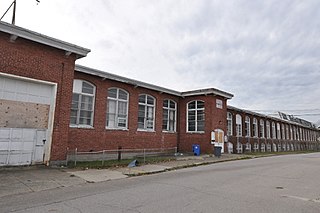
The Naushon Company Plant is a historic textile mill complex at 32 Meeting Street in Cumberland, Rhode Island. First built in 1902-04 and enlarged over time, it illustrates the adaption of the site to differing uses between then and the 1950s, when its use for textile manufacture ended. The complex was listed on the National Register of Historic Places in 1978.

The Jenckes Spinning Company is a historic textile factory complex in Pawtucket, Rhode Island. Located on Conant and Weeden Streets, the complex was developed between 1883 and 1919, and was home to the city's largest employer in the 1910s, producing cotton fabric and fabric for use in automotive tires until 1933. The factory complex was listed on the National Register of Historic Places in 2018.






















